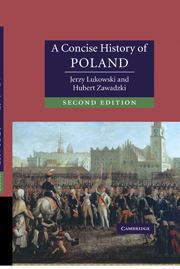Book contents
- Frontmatter
- Contents
- List of illustrations
- Preface to the second edition
- Preface to the first edition
- A note on Polish pronunciation
- Chronology
- PART I POLAND, TO 1795
- PART II POLAND, AFTER 1795
- 4 CHALLENGING THE PARTITIONS, 1795–1864
- 5 AN ERA OF TRANSFORMATION, 1864–1914
- 6 INDEPENDENCE REGAINED AND LOST, 1914–1945
- 7 COMMUNISM AND THE COLD WAR, 1945–1989
- 8 A NEW REPUBLIC, 1989–
- Generalogical charts of Polish rulers
- List of heads of state, presidents, Communist Party leaders (1918–2005)
- Bibliography
- Index
- Title in series
8 - A NEW REPUBLIC, 1989–
Published online by Cambridge University Press: 05 June 2014
- Frontmatter
- Contents
- List of illustrations
- Preface to the second edition
- Preface to the first edition
- A note on Polish pronunciation
- Chronology
- PART I POLAND, TO 1795
- PART II POLAND, AFTER 1795
- 4 CHALLENGING THE PARTITIONS, 1795–1864
- 5 AN ERA OF TRANSFORMATION, 1864–1914
- 6 INDEPENDENCE REGAINED AND LOST, 1914–1945
- 7 COMMUNISM AND THE COLD WAR, 1945–1989
- 8 A NEW REPUBLIC, 1989–
- Generalogical charts of Polish rulers
- List of heads of state, presidents, Communist Party leaders (1918–2005)
- Bibliography
- Index
- Title in series
Summary
Although many hardline Solidarity supporters resented the lack of a clean break with the communist past and no settling of scores with the communists, the constitutional changes and the elections of 1989 are now generally accepted as marking the birth of the Polish ‘Third Republic’. On 29 December 1989 Poland formally ceased to be a so-called ‘People's Republic’ and recovered the crowned white eagle as its emblem; references to the ‘leading role’ of the PZPR, to the Soviet alliance, and to socialism were expunged from the constitution. What made possible Poland's peaceful transformation in 1989–90 was the ‘self-organization’ of Polish society that had evolved since the 1970s and the self-restraint and sense of responsibility of the country's political leaders, whether communists or members of the former opposition. As a result a dangerous political vacuum was avoided and social peace was maintained. Indeed, the much greater political realism of the Poles in the second half of the twentieth century, as witnessed in 1956, in 1980–1, and now, marked a powerful contrast with the disastrous Romantic insurrections of the previous century and with the Warsaw uprising of 1944.
Mazowiecki's ‘great coalition’ showed exceptional energy in dragging Poland out of its economic marasmus. January 1990 saw the introduction of a wide-ranging programme of economic reform, the most radical in the whole of ex-communist Europe and prepared by the new finance minister Professor Leszek Balcerowicz.
- Type
- Chapter
- Information
- A Concise History of Poland , pp. 319 - 340Publisher: Cambridge University PressPrint publication year: 2006

